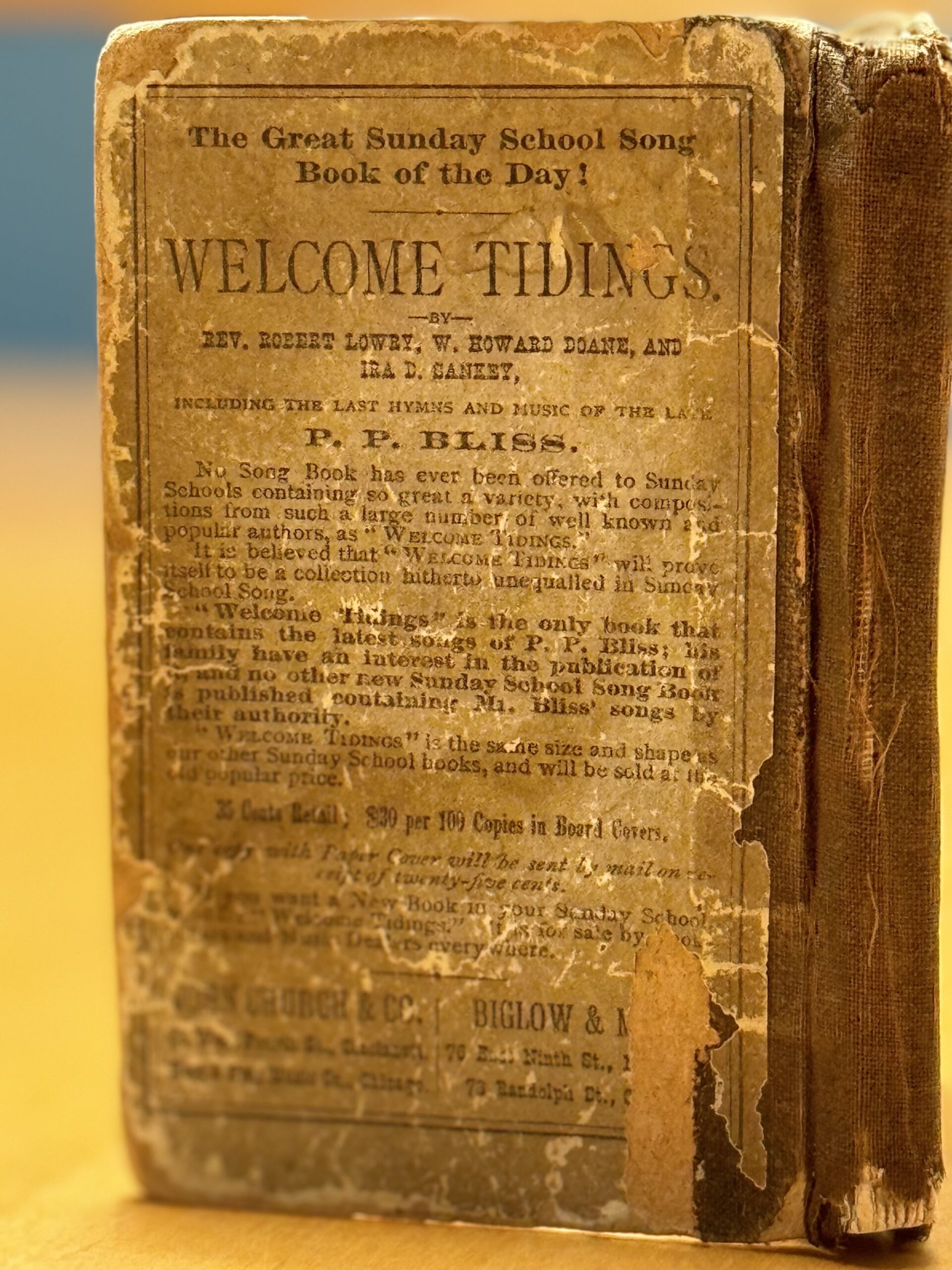Several contributors compiled the tunes of “Gospel Hymns Combined,” Ira D. Sankey, James McGranahan, and George C. Stebbin, D.L Moody, Rev. Robert Lowry, and W. Howard Doane. However, the back cover of the booklet gives special consideration to one name—P.P. Bliss (figure 1).

Figure 1: Back cover of “Gospel Hymns Combined” displaying special consideration to the works of P.P. Bliss.
Born July 9, 1838, in a log cabin nestled within the central corridor of the Pennsylvanian Appalachians just outside of Clearfield County (Reese 1999). Philip Bliss earned recognition as one of the most famous American songwriters in history. So much so, that his peers, including Ira Sankey, respected and acknowledged his superior talent (Reese, 1999).

Figure 2: Illustration of the 1876 Pacific Express Railway Accident which took the life of P.P. Bliss and 160 others.
His passion for writing Sunday school prayer melodies most likely stems from his early adoption of Christianity in his childhood as well as his work as a schoolteacher at the end of his formative years (Reese, 1999). At the age of twelve, Philip Bliss made his first public confession of Christ and joined the Baptist church. He later engaged in Methodist camp meetings and revival services (Reese, 1999). At the age of eighteen, Philip Bliss became a schoolteacher in New York where his musical talent would be recognized by a number of musical cliques (Reese, 1999). After only 4 years in New York, he returned to his home state and began tutoring pupils to supplement his income. After securing a spot and completing his stay in the Normal Academy of Music in New York, and moving to Chicago thereafter, his career eventually found great success, earning himself more than $90,000, or over three million dollars in today’s currency, nearly all of which was purportedly given to Evangelical charities (Reese, 1999). In Chicago, Bliss would mingle with other contributors of “Gospel Hymns Combined” such as D.L Moody and Ira Sankey, all of whom would regularly collaborate (Reese, 1999).

Figure 3: The Philip Paul Bliss house, reopened as the Philip P. Bliss Gospel Songwriters Museum in 1965; added to the National Register of Historical Places in 1986.
Tragedy struck Philip’s life in 1876 (Reece, 1999), when a snowdrift upturned the Pacific Express train as it passed through Ashtabula, Ohio, launching hum and 160 others from the rails and down into the icy waters of the ravine 75 feet below (figure 2). Philip Bliss never got the chance to witness the printing of “Gospel Hymns Combined” in 1879, although the book is a testament to his lifelong commitment to gospel music considering the multiple acknowledgements to his work. Philip Bliss stands alone in the musical canon of American Gospel music. His home, now known as the Philip Paul Bliss House, opened as the Philip P. Bliss Gospel Songwriters Museum in 1965 and was added to the National Register of Historical Places in 1986 (figure 3) (Ross, 2009). Just as important as Philip Bliss were the publishers who made it possible to distribute his renowned and much enjoyed music, Biglow & Main of New York and Chicago and John Church & Co. of New York and Cincinnati.

Figure 4: Formatting of Biglow & Main publishing’s first print, “Chapel Melodies,” 1868.
Founded in 1868 by Sylvester Main and his son Huberty Platt Main, Biglow & Main began as a publisher of hymnals in New York (National Endowment for the Humanities, 2024). Their first publication was “Chapel Melodies” in 1868. The title page nearly identically mirrors the formatting of “Combined Gospel Hymns” apart from the varying fonts (figure 4) and includes music notation (figure 5)—a feature they would depart from in the future publication of “Combined Gospel Hymns”. Notably, this publication also credits Rev. Robert Lowry. Perhaps as a turn of fate, the publishing house appointed Ira Sankey as president in 1895 (National Endowment for the Humanities, 2024).

Figure 5: Musical Notation included in Biglow and Main’s “Chapel Melodies,” 1868.
John Church & Co. Of New York and Cincinnati co-published this book—a music retailer and manufacturing house founded in 1859 in Cincinnati that primarily produced sheet music and pianos (Stinnet, 2024). Despite John Church’s propensity towards sheet music, the publication notably omits music notation altogether, bringing into question why exactly Biglow & Main chose Mr. Church’s company in particular to be a co-publisher of “Combined Gospel Hymns.” One reason might have been the momentum of John Church’s company at that time. Clearly, the publishing house played a significant role in the music industry of the late 1800’s, as The National Register of Historic Places added the original John Church building to their list (Stinnet, 2024), despite no longer being in operation (figure 6). Nevertheless, John Church & Co. Handled both the printing and binding of this book in-house in Cincinnati (Stinnet, 2024). John Church later expanded into cities like New York, Chicago, and Boston after finding great success in Ohio (Adams, 2021). As a result of their success in the music industry, the Royal Manufacturing Company bought Mr. Church’s company as they acquired many others into the fold in 1891 (figure 7).

Figure 7: Records of the merger between the Royal Manufacturing Company with various music manufacturing and printing houses including John Church & Co.

Figure 6: John Church & Co. Building, Chicago.
Bibliography
Reese, Ed. “Life and Ministry of Philip Bliss.” Christian Biographies, June 13 1999, https://www.wholesomewords.org/biography/biobliss.html
National Endowment for the Humanities. “Biglow & Main.” Hymnary. Accessed October 13 2024. https://hymnary.org/person/BiglowMain
Adams, Nathaniel. “John Church Company & Royal Manufacturing Company – Cincinnati, Ohio.” S. Nathaniel Adams, Documenting history as well as my experiences with repairing and restoring vintage guitars, August 17 2021. https://www.snathanieladams.com/2021/08/john-church-company-royal-manufacturing.html
Stinnet, Michael. “Church, John & Company.” Antique Piano Shop. Accessed October 13 2024. https://antiquepianoshop.com/online-museum/church-john-company/
Ross, Stephen, Ross, Dorothy. “Philip P. Bliss Songwriters Museum.” Wholesome Words. Accessed October 13, 2024. https://www.wholesomewords.org/biography/biobliss16.html
Leave a Reply